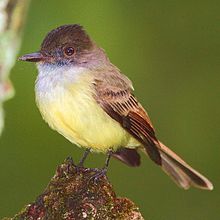The Tyranni (suboscines) are a suborder of passerine birds that includes more than 1,000 species, the large majority of which are South American. It is named after the type genus Tyrannus. These have a different anatomy of the syrinx musculature than the oscines (songbirds of the larger suborder Passeri), hence the common name of suboscines.
| Tyranni Temporal range:
| |
|---|---|

| |
| Dusky-capped flycatcher (Myiarchus tuberculifer) | |
| Scientific classification | |
| Domain: | Eukaryota |
| Kingdom: | Animalia |
| Phylum: | Chordata |
| Class: | Aves |
| Order: | Passeriformes |
| Clade: | Eupasseres |
| Suborder: | Tyranni |
| Infraorders | |
The suboscines originated in South America about 50 million years ago[1] and dispersed into the Old World likely via a trans-Atlantic route during the Oligocene.[2] Their presence in the early Oligocene of Europe is well documented by several fossil specimens.[3]
Systematics
editThe suborder Tyranni is divided into two infraorders: the Eurylaimides and the Tyrannides. The New Zealand wrens in the family Acanthisittidae are placed in a separate suborder Acanthisitti.[4]
The phylogenetic relationships of the 16 families in the Tyranni suborder is shown below. The cladogram is based on a large molecular genetic study by Carl Oliveros and collaborators published in 2019:[4] The families and the species numbers are from the list maintained by the International Ornithologists' Union (IOC).[5]
| Tyranni |
| ||||||||||||||||||||||||||||||||||||||||||||||||||||||||||||||||||||||||||||||||||||||||||
The Eurylaimides contain the Old World suboscines – mainly distributed in tropical regions around the Indian Ocean – and a single American species, the sapayoa:[4]
- Philepittidae: asities
- Eurylaimidae: typical broadbills
- Calyptomenidae: African and green broadbills
- Sapayoidae: broad-billed sapayoa
- Pittidae: pittas
The Tyrannides contain all the suboscines from the Americas except the broad-billed sapayoa. The families listed here are those recognised by the International Ornithologists' Union.[5]
- Pipridae: manakins
- Cotingidae: cotingas
- Tityridae: tityras, sharpbill, becards (includes Oxyruncus and Onychorhynchus)
- Tyrannidae: tyrant-flycatchers (includes Piprites, Platyrinchus, Tachuris and Rhynchocyclus)
- Melanopareiidae: crescent chests
- Conopophagidae: gnateaters and gnatpittas
- Thamnophilidae: antbirds
- Grallariidae: antpittas
- Rhinocryptidae: tapaculos
- Formicariidae: antthrushes
- Furnariidae: ovenbirds and woodcreepers (includes Dendrocolaptidae)
This group has been separated into three parvorders by Sibley & Ahlquist. However, DNA:DNA hybridization did not reliably resolve the suboscine phylogeny. It was eventually determined that there was a simple dichotomy between the antbirds and allies (tracheophones), and the tyrant-flycatchers and allies.[6] Given that the "parvorder" arrangement originally advanced is obsolete (see e.g. Irestedt et al. 2002 for tracheophone phylogeny) — more so if the Eurylaimides are elevated to a distinct suborder — it is better to rank the clades as superfamilies or, if the broadbill group is considered a separate suborder, as infraorders. In the former case, the name Furnarioidea would be available for the tracheophones, whereas "Tyrannoidea", the "bronchophone" equivalent, has not yet been formally defined.[7] In the latter case, the tracheophones would be classified as "Furnariides",[8] while the Tyrannides would be restricted to the tyrant-flycatchers and other "bronchophone" families.
The tracheophones contain the Furnariidae, Thamnophilidae, Formicariidae (probably including most tapaculos), and Conopophagidae. The tyrant-flycatcher clade includes the namesake family, the Tityridae, the Cotingidae, and the Pipridae.
References
edit- ^ Claramunt, S.; Cracraft, J. (2015). "A new time tree reveals Earth history's imprint on the evolution of modern birds". Science Advances. 1 (11): e1501005. doi:10.1126/sciadv.1501005. PMC 4730849.
- ^ Selvatti, A. P.; Galvão, A.; Mayr, G.; Miyaki, C. Y.; Russo, C A. de Moraes (2022). "Southern hemisphere tectonics in the Cenozoic shaped the pantropical distribution of parrots and passerines". Journal of Biogeography. 49 (10): 1753–1766. doi:10.1111/jbi.14466.
- ^ Bochenski, Z. M.; Tomek, T.; Bujoczek, M.; Salwa, G. (2021). "A new passeriform (Aves: Passeriformes) from the early Oligocene of Poland sheds light on the beginnings of Suboscines". Journal of Ornithology. 162 (2): 593–604. doi:10.1007/s10336-021-01858-0.
- ^ a b c Oliveros, C.H.; et al. (2019). "Earth history and the passerine superradiation". Proceedings of the National Academy of Sciences of the United States of America. 116 (16): 7916–7925. doi:10.1073/pnas.1813206116. PMC 6475423. PMID 30936315.
- ^ a b Gill, Frank; Donsker, David; Rasmussen, Pamela, eds. (January 2023). "Family Index". IOC World Bird List Version 13.1. International Ornithologists' Union. Retrieved 5 March 2023.
- ^ A conceivable vernacular name would be "bronchophones". This would parallel the German vernacular names, Luftröhrenschreier (tracheophones) and Bronchienschreier (bronchophones).
- ^ And thus should not be used without quotation marks.
- ^ See remark at "Tyrannoidea". This peculiarity is explained by the fact that Sibley & Ahlquist's analyses erroneously suggested an overly complex phylogeny for the tracheophones, and a much simpler one for the tyrant-flycatchers and allies.
Further reading
edit- Ohlson, J.I.; Irestedt, M.; Ericson, P.G.P.; Fjeldså, J. (2013). "Phylogeny and classification of the New World suboscines (Aves, Passeriformes)". Zootaxa. 3613 (1): 1–35. doi:10.11646/zootaxa.3613.1.1. PMID 24698900.
- Irestedt, Martin; Fjeldså, Jon; Johansson, Ulf S. & Ericson, Per G.P. (2002): Systematic relationships and biogeography of the tracheophone suboscines (Aves: Passeriformes). Molecular Phylogenetics and Evolution 23(3): 499–512. doi:10.1016/S1055-7903(02)00034-9 (HTML abstract)
- Selvatti, A.P.; Galvão, A.; Pereira, A.G.; Pedreira Gonzaga, L.; Russo, C.A.D.M. (2017). "An African origin of the Eurylaimides (Passeriformes) and the successful diversification of the ground-foraging pittas (Pittidae)". Molecular Biology and Evolution. 34 (2): 483–499. doi:10.1093/molbev/msw250. PMID 28069777.